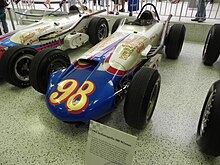 | |||||
| Indianapolis Motor Speedway | |||||
|---|---|---|---|---|---|
| Indianapolis 500 | |||||
| Sanctioning body | USAC | ||||
| Season | 1963 USAC season | ||||
| Date | May 30, 1963 | ||||
| Winner | Parnelli Jones | ||||
| Winning team | Agajanian Racing Enterprises | ||||
| Average speed | 143.137 mph (230.357 km/h) | ||||
| Pole position | Parnelli Jones | ||||
| Pole speed | 151.153 mph (243.257 km/h) | ||||
| Fastest qualifier | Parnelli Jones | ||||
| Rookie of the Year | Jim Clark | ||||
| Most laps led | Parnelli Jones (167) | ||||
| Pre-race ceremonies | |||||
| National anthem | Purdue Band | ||||
| "Back Home Again in Indiana" | Brian Sullivan | ||||
| Starting command | Tony Hulman | ||||
| Pace car | Chrysler 300 | ||||
| Pace car driver | Sam Hanks | ||||
| Starter | Pat Vidan[1] | ||||
| Honorary referee | Baxter F. Ball[1] | ||||
| Estimated attendance | 250,000[2] | ||||
| TV in the United States | |||||
| Network | N/A | ||||
| Announcers | N/A | ||||
| Nielsen ratings | N/A / N/A | ||||
| Chronology | |||||
| |||||
The 47th International 500-Mile Sweepstakes was held at the Indianapolis Motor Speedway in Speedway, Indiana on Thursday, May 30, 1963. Rufus Parnelli Jones took his only Indy 500 win. This win was controversial because his car (nicknamed "Calhoun") spewed oil from a cracked overflow tank for many laps, which allegedly caused at least one driver to spin and crash. USAC officials put off black-flagging Jones after car owner J. C. Agajanian ran down pit lane and convinced them that the oil leak was below the level of a known crack and would not leak any further.[3] Lotus owner Colin Chapman, whose English-built, rear-engined Lotus-Ford finished second in the hands of Scotsman Jim Clark, accused USAC officials of being biased in favor of the American driver and car.
The non-black flagging of Jones remains controversial. Many, including Chapman and writer Brock Yates, believed that officials would have black flagged Jones if an American driver and car had been in second place instead of Clark in the British built Lotus. Goodyear arrived at the track and supplied tires for some entries, but participated only in practice. No cars used Goodyear tires during time trials or the race itself. It was the first time since about 1921 that Goodyear attempted to compete at Indy. Goodyear had last won the race in 1919.
- ^ a b Fox, Jack C. (1994). The Illustrated History of the Indianapolis 500 1911-1994 (4th ed.). Carl Hungness Publishing. p. 22. ISBN 0-915088-05-3.
- ^ Cadou Jr., Jep (May 31, 1963). "Shatter Track Record With Hot 143.137 Average". The Indianapolis Star. p. 1. Retrieved June 2, 2017 – via Newspapers.com.

- ^ "Fist Fight Breaks Out Between Speedway Winner Parnelli Jones and Eddie Sachs". Lewiston Daily Sun. June 1, 1963. Retrieved March 21, 2013.